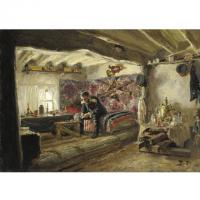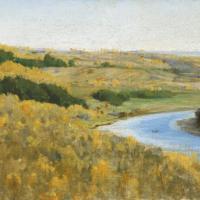Vasily Dmitrievich Polenov
The Gulf Of Smyrna
$450.00
Vasily Dmitrievich Polenov
Vasily Dmitrievich Polenov (1844-1927)
Vasily Dmitrievich Polenov (1 June 1844 – 18 July 1927) was a Russian landscape painter associated with the Peredvizhniki movement of realist artists. His contemporaries would call him the “Knight of Beauty” as he embodied both european and russian traditions of painting. His vision of life was summarized as following: “Art should promote happiness and joy”. As a painter and a humanist, he would truly believe in the civilizing mission of Art, Culture and Education.
As one of the best students of the Imperial Academy of Fine Arts, he received the Great Medal for his painting The Resurrection of the daughter of Jairus (1871, Museum of the Academy of Fine Arts, St. Petersburg). This work was his first approach to a biblical theme for which the young artist had a deep interest. The price he received for this painting allowed him, along with other laureates, to become a pensioner (scholarship’s owner) abroad and live in Europe at the expenses of the Russian State. At the end of the summer of 1872, Vasily Polenov crossed Germany and Switzerland before settling in Venice and then Rome the following year. His Italian stay did not stimulate him much, he lacked from inspiration and worked very little. Nevertheless there, two major encounters happened and shaped his lifetime work. In "the Eternal City", he felt in love with the young Maroussia Obolenskaya who tragically died the same year of measles. However, Rome, has also been the scene of a fruitful and exciting meeting with Savva Mamontov (1841–1918), a rich entrepreneur, art lover and philanthrope. Together, in Italy, they were already planning to create a circle of multidisciplinary artists. The Mamontov’s estate in Abramtsevo seemed to be the ideal place to set up some artists' studios and a theater.
During these years, the painter tried all kinds of painting in order to find his true talent. He painted historical scenes (The Arrest of the Huguenot, thanks to which he will obtain the title of Academician), daily life scenes, portraits and many Normandy’s landscapes. When he returned from his trip, he made a decisive statement for his career: "There, I tried all kinds of painting [...], and I came to the conclusion that I have mostly talent for landscapes and scenes of everyday life, which I will exploit in the future."
During the 1880s, his work was spotted by Vladimir Stassov, a supporter of the traveling exhibition society (the Wanderers), which he joined then. This artistic movement was born from the desire to break with the themes imposed by the Academy to better represent contemporary concerns. In addition, the members promote the accessibility of art among the people by organizing traveling exhibitions (not limited to the artistic centers of Moscow and St. Petersburg). Through their eminently realistic painting, they seek to denounce the living conditions of the Russian population and to promote greater literacy. His works won the admiration of Pavel Mikhailovich Tretyakov, who acquired many of them for his gallery. He was one of the first Russian artists who achieved a plein air freshness of color combined with artistic finish of composition (The Moscow courtyard, 1878; The Grandmother's garden, 1878; Overgrown pond, 1879). The principles developed by Polenov had a great impact on the further development of Russian (and especially Soviet) landscape painting.
He also began to attend retreats of the Abramtsevo circle. The name comes from the village where the property of Savva Mamontov is. Savva and Vasily had met a decade before in Italy and were now ready to create together surrounded by artists from all disciplines. The very essence of this place was to give freedom of creation, renouncing to academic aesthetic canons. Savva Mamontov would animate his workshops based on traditional art and russian folklore.
There, all art practices were combined: painting, architecture, music but also decorative and popular arts such as wood crafting and ceramics. In addition to Polenov, the main artists that took part of the circle were Repin, Viktor Vasnetsov, Constantin Korovin, Mikhail Vrubel, Elena Polenova (Polenov's younger sister, a brilliant watercolourist and ceramist), Mikhail Nesterov, Maria Iakountchikova (future sister-in-law of the artist) ...
From 1883 to 1895, Polenov coached many young artists at the Moscow School of Painting, Sculpture and Architecture. His most talented students are Abram Arkhipov, Isaac Levitan, Konstantin Korovin and Alexander Golovine. The artist was very important to the teaching of the technique, being very demanding on the quality of colors and canvases. In 1893 he became a member of the Academy of Fine Arts in St. Petersburg. Polenov was elected a member of the St.Petersburg Academy of arts in 1893.
In the late 1880s, Polenov dreamed of a house-museum in the countryside in order to spread the benefits of a rich cultural life. He wanted to create his own place of creation and education but also a place where he could expose the archaeological and artistic collections gathered by his family along the decades. In 1889, he made a trip to the area of Taroussa, 130 km south of Moscow, with his friend and disciple Constantin Korovine. Struck by the beauty of the place, he decided that he will make his dream true there, on the banks of the river Oka. Thanks to the purchase by Tsar Alexander III of his painting Christ and the sinner(1884) for the amount, huge at the time, of 30 000 rubles, he bought a sandy hill overlooking the river, not far from the small village of Bekhovo.
The house, built based on the model his childhood’s house in Imotchentsy, was completed in 1892. It is a large three-storey wooden building. He realized himself the plans the design of it and the general style approaches Art Nouveau, which he himself called "Scandinavian", mixing Romanesque and Gothic architecture but also Western medieval style. From the outside, the house remains very original by multiplying volumes and facades, varying the roofs’ shapes and sizes. The ground floor is occupied by common rooms (library, dining room, games room). On the upper floors are the living rooms, Polenov's workshop and his wife's office. Large windows are arranged to admire the view of the Oka and Taroussa at the time. Since then, the trees planted by the artist, his children and local peasants, are closing a little bit the view but offers a dense forest. Pines mainly grew up on this sandy land. Little by little, he also built annexes: a cart shed, stables, a house for the workers, "the admiralty", intended to be the house for the boats (today the room is dedicated to the diorama), a small isba for children, and finally Polenov's final workshop, "the abbey" a large brick building to be his last studio (it was also used for theatrical performances).
Paying tribute to the family’s humanist tradition, the Polenov improved the living conditions of the surroundings ’populations. Struck by the pitiful state of schools and the difficult living conditions of the teachers, with his wife they built two schools and organized cultural trips to Moscow for the instructors. To meet the needs of the peasants, they also build a church of which Polenov is the architect. Children from surrounding villages are regularly invited to theatrical performances at the estate, "Old Borok". In 1918, after the Revolution, the house-museum became the first national museum and was renamed Polenovo after the death of the artist, in 1927. Polenov's great-granddaughter Natalia Polenova has been a director of Polenovo since 2011.





